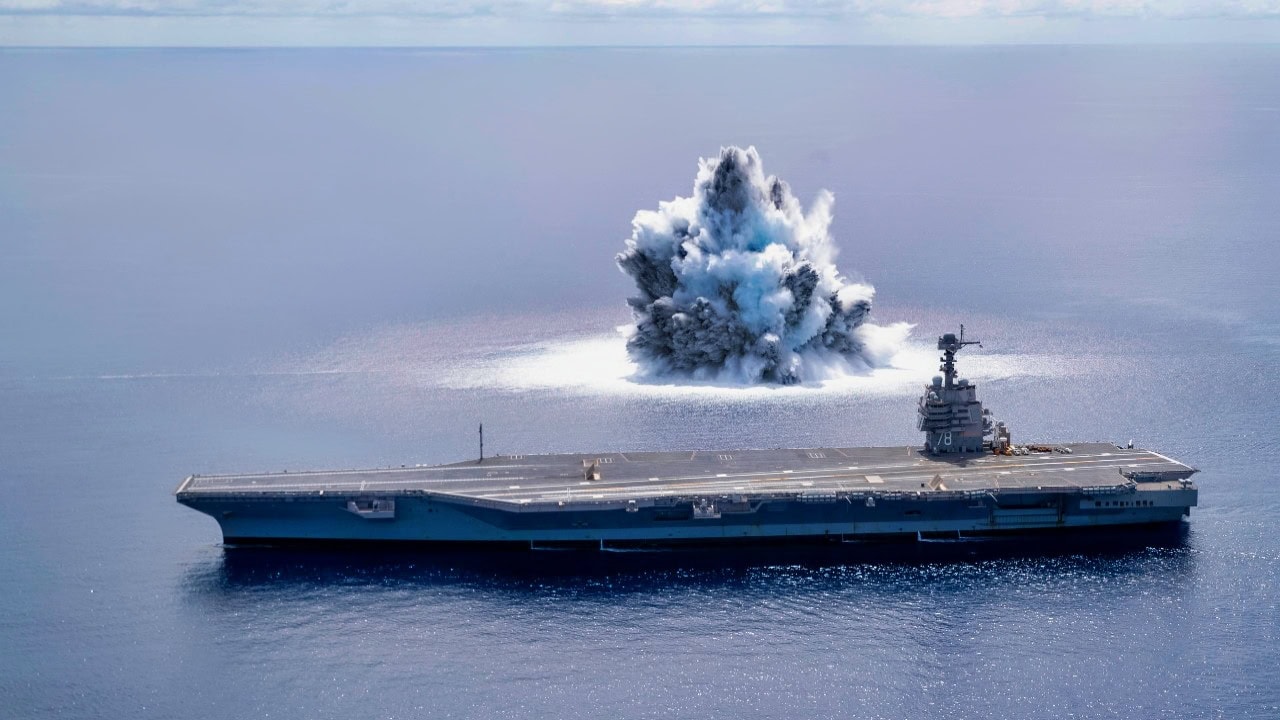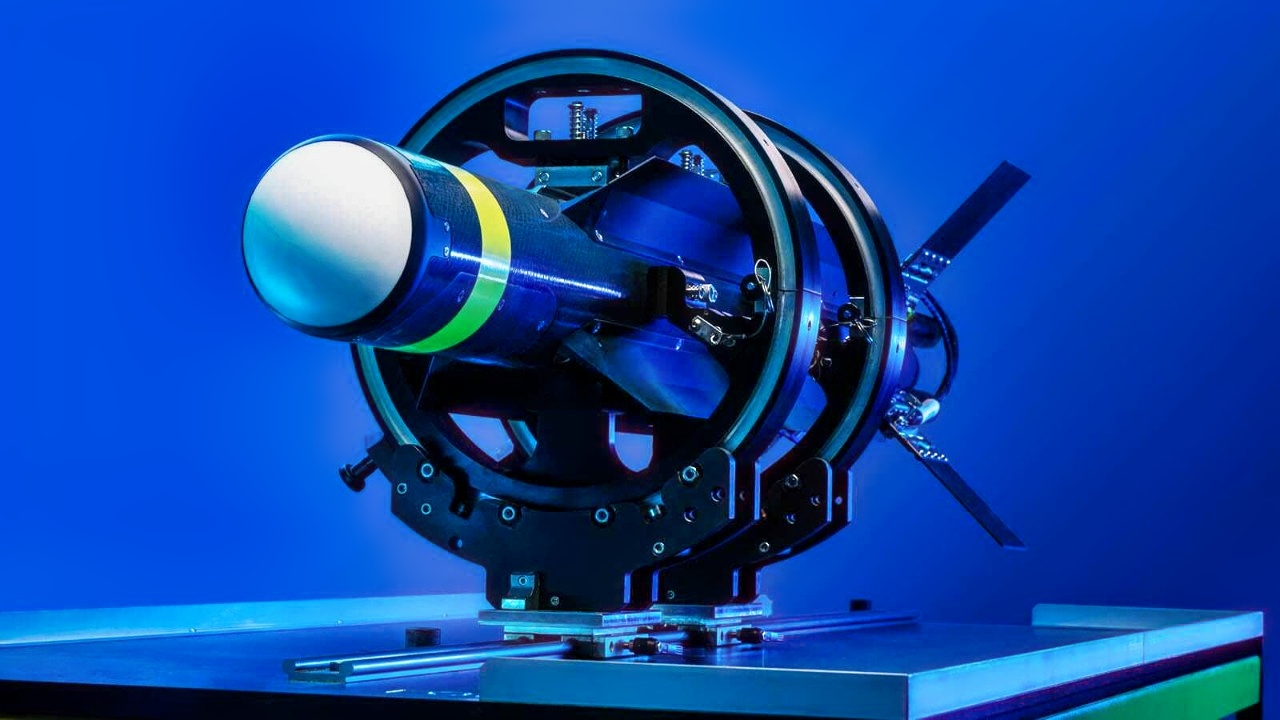Key Points: The U.S. Navy is bolstering carrier defenses with Raytheon’s Coyote and Anduril’s Roadrunner-M drone interceptors.
-These turbojet-powered, loitering drones are specifically designed to counter swarms of low-cost enemy drones—a growing threat from adversaries like Iran and China.
-Equipped with advanced radars, Coyote and Roadrunner-M intercept incoming threats at short range, offering significant savings compared to traditional missiles.
-Impressively, some interceptors can return, land on the ship, refuel, and launch again.
-Already combat-proven by the Army and Special Operations, these drone defenders represent an affordable yet powerful addition, dramatically expanding protective firepower for America’s multi-billion-dollar carrier strike groups.
Aircraft Carriers Have a New Defense
America’s aircraft carriers will now be defended by Raytheon’s Coyote and Anduril’s Roadrunner-M interceptors. These are advanced new turbojet-powered drone interceptor missiles that can loiter in the airspace around the carrier strike group to rapidly engage incoming drone swarms.
And once the job is done, some of the interceptors left will be able to fly back to the ship, land, refuel, and launch again. Both weapons have already seen combat with the U.S. Army and Special Operations Command.
Military.com was the first to report on the addition of two new counter-drone missile systems to Arleigh Burke-class guided missile destroyers assigned to the USS Gerald R. Ford carrier strike group. These ships already boast some of the world’s most advanced surface-to-air missile systems, capable of engaging airborne threats ranging from sea-skimming cruise missiles all the way up to ballistic missile warheads outside the earth’s atmosphere – but this level of capability comes at a significant cost.
The cheapest of these weapons, the Evolved Sea Sparrow Missile, or ESSM, costs around $1.5 million per shot. SM-2 interceptors, which engages targets farther away cost a hefty $2.5 million a piece. And the even more dynamic SM-6 – a weapon that’s so capable it’s even been converted into America’s furthest-reaching air-to-air missile – rings in at $4.3 million each. Yet, these weapons were designed to take down threats that are often even more expensive, like fighters or bombers, among other things, and of course, the vessels they protect are worth billions, making their defense well worth the price.
But the advent of relatively low-cost one-way attack drones has completely changed the arithmetic of these seaward battlefields, with adversaries like Iran and its many proxy forces launching higher volumes of much cheaper drones at far-flung targets in hopes of overwhelming their air defenses. If Iran and its proxies, like the Houthis, can cause problems with these one-way attack drones, a wealthier adversary with a significantly larger industrial base – like China – could field enough to absolutely wreak havoc on American carrier strike groups.
And that’s where Raytheon’s Coyote and Anduril’s Roadrunner-M interceptors come in.
The original Coyote AAV was developed by Advanced Ceramic Research, prior to the company being purchased by BAE Systems in 2009, and then eventually finding its way to maturing under the Raytheon banner starting in 2015. At the time, it was a small propeller-driven, expandable aircraft system launched out of small canisters before its two sets of rectangular wings deployed. These systems were originally envisioned as low-cost intelligence, surveillance, and reconnaissance (ISR) assets, deployed from any number of platforms before patrolling the area and relaying video or other intelligence back to ground forces.
But in 2020, Raytheon’s Coyote Block II was unveiled which omitted the piston-driven propeller and deployable wings in favor of a new turbojet propulsion system and four moving control surfaces on the tail, making it look much more like a missile.
And in keeping with that weaponized aesthetic, these systems were no longer relegated to capturing intelligence but were turned into fully armed drone hunters: They were packed with roughly four-pound blast fragmentation warhead in their fuselage along with a proximity fuse meant to detonate the charge as soon the new Coyote found its prey. According to Raytheon, those small moving fins and the Coyote’s new air-breathing jet engine give the weapon “dogfight-type capability” to close with even extremely maneuverable drone targets.

SOUTH CHINA SEA (Jan. 17, 2025) – The Nimitz-class aircraft carrier USS Carl Vinson (CVN 70) transits the South China Sea during a Maritime Cooperative Activity with the Philippine Navy, Jan. 17, 2025. The U.S. and Philippines work together as allies, enhancing the interoperability of maritime forces and supporting their shared goal of a free and open Indo-Pacific. Carrier Strike Group ONE, is underway conducting routine operations in the U.S. 7th Fleet area of operations. (U.S. Navy photo by Mass Communication Specialist 3rd Class Brianna Walker)
The speed of the Coyote interceptors is confidential but has been reported as 345 to 370 miles per hour by some outlets. The Coyote’s guidance system is accurate enough to directly impact an airborne target in testing, though in practice, it wouldn’t need to. While the four-pound warhead may be tiny compared to the 44-pounds of explosives you’d find in a new AIM-120 AMRAAM, it’s designed to produce a “fragment field” upon detonation that’s more than enough to bring down even fairly large drone weapons.
In order to maximize the efficacy of these drone interceptors without ramping up the price per missile, Raytheon’s paired them with its surface-based Ku-band multi-mission radar array dubbed KuRFS, short for Ku-band Radio Frequency Sensor.
This system combines target tracks collected via multiple antennas, making it capable of spotting everything from inbound mortars to larger attack drones. Raytheon claims it has the fidelity to spot airborne targets as small as a 9mm bullet. Target tracks are transmitted to receivers onboard the Coyote intercept
The Army has already deployed these Coyote Block II interceptors as a part of what they call the Low, Slow, Unmanned Aircraft Integrated Defeat System, or LIDS, which includes both mobile and fixed launchers. Now, the different components of the KuRFS radar and Coyote launch tubes are often distributed across multiple platforms, but in the near future, the Army intends to field it all in a single 8×8 Stryker light armored vehicle.
These systems have already seen combat, and according to the Army, have already intercepted over 170 inbound drones. One of the few engagements the public has been made aware of came in January 2023, when Coyote Block II interceptors took down two incoming one-way attack drones targeting American troops in Southeastern Syria.

The aircraft carrier USS Gerald R. Ford (CVN 78) completes the first scheduled explosive event of Full Ship Shock Trials while underway in the Atlantic Ocean, June 18, 2021. The U.S. Navy conducts shock trials of new ship designs using live explosives to confirm that our warships can continue to meet demanding mission requirements under harsh conditions they might encounter in battle. (U.S. Navy photo by Mass Communication Specialist 3rd Class Riley B. McDowell)
These small interceptors are meant as a short-range defensive asset, capable of taking down incoming drones as far out as 9.3 miles (about 15 kilometers), and according to reports, they can loiter around the carrier strike group for as long as four or so minutes before taking down a target.
And at around $100,000 each, these broadly capable drone-killers ring at about 1/15th the cost of the Navy’s cheapest short-range interceptors, the Evolved Sea Sparrow II, which ring at around $1.5 million and can engage airborne targets at better than 30 miles away.
The Coyote and Roadrunner-M, it’s important to note, are not meant to serve as replacements for any of the Navy’s existing defenses. Instead, they will provide commanders with more options to assess and engage approaching threats.
Further they will also provide the strike group with a big boost in magazine capacity and with more defensive firepower without, it seems, sacrificing any additional VLS launch tubes to the job. Eventually, these new ship defenses will be further bolstered by high-energy lasers, like the Navy’s HELIOS system that’s currently in testing, to add yet another significant short-range defensive capability.
About the Author: Alex Hollings
Alex Hollings is the editor of the Sandboxx blog and a former U.S. Marine that writes about defense policy and technology. He lives with his wife and daughter in Georgia. This first appeared in Sandboxx.

